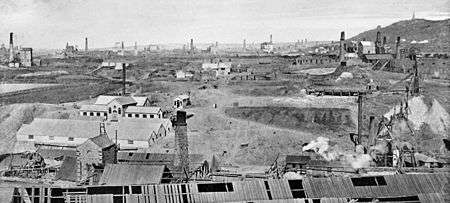Tuckingmill, Camborne, Cornwall
Tuckingmill (Cornish: Talgarrek, meaning hill-brow of a rock) is a village in Cornwall, England, United Kingdom.
The parish of Tuckingmill was constituted in 1845 being carved out of a western section of the parish of Illogan and an easterly section of Camborne parish. It covers 1,300 acres (5.3 km2). Tucking Mill (Cornish: Melyn Droghya, from the verb troghya) was the Cornish term for a fulling mill which was where homespun cloth was dipped, cleansed and dressed. There is a mention of a fulling mill in this region as early as 1250.
Religion
The parish church of All Saints was built in 1843–44 in the Norman Revival style with the north aisle having a heavy granite arcade. The architect was John Hayward of Exeter. The Norman font came from the chapel at Menadarva.[1] The church was renovated in 1878–79 by Piers St Aubyn with the raising and tiling of the chancel, removing the tower gallery, replacing the seats and repairing the walls and windows. A new organ costing £120 was purchased from Hele and Sons of Plymouth. The church was re-opened on Thursday, 20 February 1879.[2]
Industry
Situated within the parish was the Bickford Fuse Factory, where the world’s first safety fuse was invented and manufactured by William Bickford. A centre of the mining industry the parish contained, amongst many others, the greatest of all Cornish mines, Dolcoath Mine. Also in the parish is South Crofty Mine which was at one time the deepest in the world as well as being the last tin mine in Europe, only closing in 1998.

Economy and development
The area consists of terraced miners' cottages and rather barren industrialisation. With the demise of this economic activity, many thousands of jobs were lost and Tuckingmill became a bleak post-industrialisation urban area. However, in recent years regeneration has picked up and improvements are expected over the next few years. Kerrier Council's bid for £23 million from the BIG Lottery Fund was successful - and announced in November 2007. The grant will be used to re-build the Pool area between Redruth and Camborne (Pool sits at the top of East Hill, immediately next to Tuckingmill).
A Cornish property development firm called Porthia acquired a huge site at the centre of Tuckingmill. The site includes the old Fuseworks building and brownfield land previously mined by South Crofty. It was their intention to transform this site into "New Tuckingmill" - a development of over 400 new homes as well as commercial space and community facilities.Porthia's environmental proposal failed to satisfy Kerrier Council, so it stalled.
Notable residents
William Bickford, inventor of the safety fuse, lived and worked in Tuckingmill.
References
External links
![]() Media related to Tuckingmill at Wikimedia Commons
Media related to Tuckingmill at Wikimedia Commons
Coordinates: 50°14′N 5°17′W / 50.233°N 5.283°W